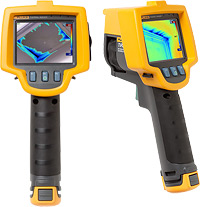Use of Thermal Imaging for Home Inspections
Thermal imaging can be a useful tool during a home inspection. Thermal imaging equipment uses infrared technology to detect very minute differences in surface temperatures of solid objects such as walls and ceilings. Surface temperature differences can be subtle or dramatic; with infrared technology, it is possible to observe slight temperature differences that would be undetectable using conventional inspection methods.
To understand thermal imaging, it is necessary to gain a basic understanding of the principles involved in infrared technology. The human eye cannot see infrared energy because it has a longer wavelength than visible light. Infrared energy is part of the electromagnetic spectrum that we detect as heat. All surfaces and objects produce heat. The greater the surface temperature, the more infrared energy that is produced and the greater the thermal signature.
Thermal imaging can be used in NJ home inspections to identify:
- Areas of missing or wet insulation
- Heat loss and air infiltration in walls, ceilings, floors, windows, and doors
- Water and moisture intrusion that can lead to mold growth and wood rot
- Roof leaks
- Energy loss (areas of poor efficiency)
- Some electrical faults and defects
Infrared cameras are a great inspection tool if used in conjunction with a complete New Jersey home inspection. They are not meant to take the place of a home inspection. For example, it is not always clear whether a thermal signature indicates moisture or a water leak. A NJ home inspector should attempt to confirm the finding by using a moisture meter. Your complete NJ home inspection also includes evaluation of potential defects which are not detectable via thermal imaging alone.
Frequently Asked Questions
Can infrared cameras see through walls like an x-ray?
No. Infrared imaging can detect temperature differences only on an object's surface. Thermal imaging is not an x-ray nor a method to view inside of walls or ceiling structures.
How does thermal imaging detect moisture in walls and ceilings?
Thermal imaging identifies differences in temperature between a wet area and surrounding dry areas. As moisture evaporates, it creates a cooling effect. It is this temperature difference between the drying area and the nonaffected area that produces the thermal signature. In other words, thermal imaging does not "see" moisture; it only detects surface temperatures. For this reason, suggestive findings should be confirmed with a moisture meter.
Can thermal imaging show me areas of air infiltration or heat loss?
Yes. In fact, this is a use for which infrared technology truly excels as an inspection tool. It can detect both areas of air leakage and areas of air infiltration. However, for thermal imaging to be effective for this purpose, the temperature difference between the inside and outside air must be at least 15°F. If temperatures are the same outside and inside the home, infrared technology is of little use in detecting air infiltration or heat loss.
What conditions are best to get the most out of infrared technology?
As explained above, thermal imaging works best when there is a significant difference between the temperature inside a home and outdoors. It is also very useful to perform an infrared scan of the home shortly after a rainstorm, which may allow for detection of temperature differences attributable to hidden moisture. If it has not rained for several days prior to the scan, areas of leakage or water infiltration may be dry, which makes them less detectable with thermal imaging.
What time of the day is it best to use infrared technology?
It is advantageous in most cases to use infrared technology in the morning hours. In the morning, there is usually a natural temperature difference between the inside and the exterior temperatures. Infrared technology can be used at other times during the day, but conditions may have to be artificially manipulated in order to get the most benefit from the infrared technology. For example, it may be necessary to operate the air conditioner in the home during a summer afternoon or the heat on a cold day in order to increase the difference in temperature between the inside and the exterior. Thermal imaging may be less successful in the middle of a hot summer day in a home that does not have central air conditioning.
In Short…
Thermal imaging using infrared technology is a useful tool. It is not a magic technology that will uncover all hidden defects. Used with other inspection tools, it can enhance a thorough home inspection. The more information you have regarding a home of interest to you, the better you will be able to make informed decisions about its purchase or upkeep.
Make sure to ask me about adding an infrared scan to your home inspection!
LookSmart Home Inspections, LLC
New Jersey member of the Independent Home Inspectors of America
Member American Society of Home Inspectors
Member New Jersey Association of Professional home Inspectors
Member New Jersey Chapter of the American Society of Home Inspectors
LookSmart performs licensed home inspections in New Jersey.
LookSmart provides NJ Home inspections by a certified NJ home inspector in the following
New Jersey counties: Bergen, Essex, Hudson, Hunterdon, Middlesex, Morris, Passaic,
Somerset, Sussex, Union and Warren counties. We'll be more than happy to expand into additional
New Jersey counties upon your request. Just ask.
